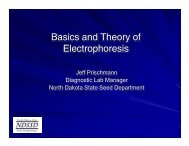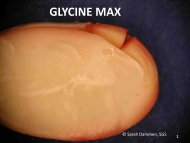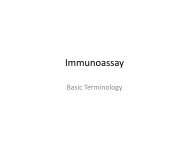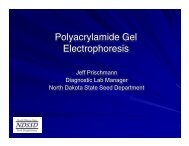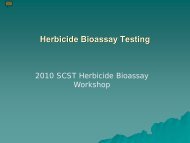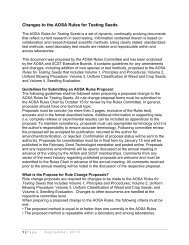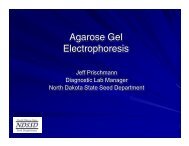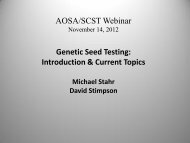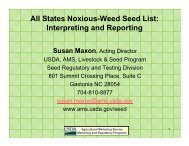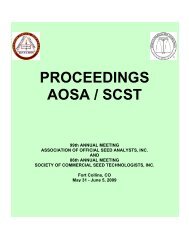Herbicide Bioassay Testing
Herbicide Bioassay Testing
Herbicide Bioassay Testing
Create successful ePaper yourself
Turn your PDF publications into a flip-book with our unique Google optimized e-Paper software.
<strong>Herbicide</strong> <strong>Bioassay</strong><br />
<strong>Testing</strong>
<strong>Testing</strong> Methods<br />
Rules for <strong>Testing</strong><br />
– What? No rules??<br />
Pre-soak<br />
Greenhouse<br />
Substrate imbibtion
Pre-Soak<br />
Seed is soaked in herbicide solution<br />
16h. Drain.<br />
Place imbibed seeds on watered<br />
media<br />
Evaluate after 7 days
Greenhouse<br />
Grow plants for 14 days<br />
Spray with herbicide<br />
Evaluate at 21d
Substrate Imbibtion<br />
Apply herbicide concentration<br />
uniformly to substrate<br />
– Rolled Towel<br />
– Crepe cellulose/Tray<br />
Evaluate after 7 days
<strong>Bioassay</strong>s<br />
Developing<br />
Evaluating (AOSA Rules)<br />
Watch outs<br />
– Distinguishing weak/diseased seedlings<br />
from non-trait<br />
– Uniform herbicide application<br />
– Correct herbicide concentration
<strong>Bioassay</strong> <strong>Testing</strong><br />
1. Mix herbicide<br />
2. Apply to media<br />
3. Place 400 seed<br />
4. Place Negative and<br />
Positive check seed<br />
5. Incubate<br />
6. Evaluate normals,<br />
abnormals using<br />
AOSA Rules for<br />
Germination<br />
7. Report
<strong>Herbicide</strong>s<br />
Working with herbicides<br />
– AI<br />
– Concentrations<br />
– Stock solutions<br />
– Adjuvant, surfactants<br />
– Shelf life<br />
– MSDS<br />
– PPE<br />
– Cross contamination
<strong>Herbicide</strong> Concentrations<br />
Determine optimum ppm<br />
Calculate amount of herbicide &<br />
water<br />
100ppm = .01% solution<br />
75% AI = 75/100g is active<br />
500 ml of 100 ppm solution<br />
X=(0.0001)(500ml) / 0.75AI<br />
x=0.0667g of 75% AI
Evaluating <strong>Herbicide</strong> Trait Tests<br />
• Verify negative and positive check<br />
seeds<br />
• Evaluate test sample<br />
• Count normal seedlings<br />
• Count non-trait seedlings<br />
• Calculate the percentage of trait<br />
seedlings<br />
# trait seedlings<br />
# normal seedlings
Reporting<br />
% Trait tolerance<br />
(# trait/# normals)<br />
% germination (unofficial)<br />
(# normals/#seed tested)<br />
Number of seed tested
Quality Levels for Traits<br />
Developer quality levels<br />
– Bayer<br />
– BASF<br />
– Dow<br />
Audits<br />
-Syngenta<br />
-Monsanto<br />
-DuPont
Corn & Soybean Traits<br />
Crops<br />
Corn<br />
Soybean<br />
GMO<br />
RR, LL<br />
RR, (LL)<br />
Non-GMO<br />
Clearfield<br />
STS
Non-Trait Dicot Seedlings<br />
Inhibition of secondary root growth<br />
and hairs<br />
Shortened hypocotyl growth<br />
Browning of root tip and hypocotyl<br />
tissue<br />
Inhibition of unifoliate leaf<br />
development
Non-Trait Monocot Seedlings<br />
Inhibition of root growth and hairs<br />
Shortened shoot growth<br />
Browning of mesocotyl tissue<br />
Lack of chlorophyll development<br />
Clear coleoptiles with stunted<br />
plumules
Liberty Link ® (LL), PAT<br />
Corn (1996), Soybeans (1998)<br />
Glutamine synthetase enzyme<br />
PAT (Phosphinothricin(<br />
N-<br />
acetyltransferase)<br />
BAR gene-T25<br />
– Bt11 gene (also has Cry1ab gene)<br />
– Agrisure (HB)<br />
– HX (Cry1f/LL)<br />
Glufosinate: Liberty ® Ignite ® AgrEvo<br />
Stick Test
Liberty Link Corn (96%)<br />
•Inhibition of root growth and hairs<br />
•Browning of mesocotyl tissue<br />
•Inhibition of chlorophyll production & shoot development
Various Growth levels of<br />
Non-Trait Liberty Seedlings
Clearfield IMI/PT<br />
Clearfield/IMI PT<br />
Corn 1994 (IMI), Pursuit ® (PT),<br />
Clearfield ® (CL)<br />
Imidazolinone herbicide<br />
Imazethapyr(IMI)<br />
Acetolactate synthase(ALS enzyme)<br />
ALS1, ALS2 gene<br />
Lightning ® , Pursuit ® BASF
Clearfield Corn (97%)<br />
Non-trait<br />
trait<br />
•Shortened<br />
shoot<br />
growth<br />
•Inhibition<br />
of root<br />
growth and<br />
hair.
Roundup Ready<br />
Glyphosate tolerant<br />
Soybean & corn<br />
– CP4 - EPSPS gene<br />
– EPSPS (5-enolpyruvyl<br />
enolpyruvyl-shikimate 3<br />
phosphate-synthase<br />
synthase) ) enzyme<br />
GA21 – phased out RR1.<br />
NK603- most current hybrids.<br />
RR2. Stick test.<br />
Monsanto, Syngenta
Roundup Ready Soybean (99%)<br />
Shortened<br />
hypocotyl<br />
growth<br />
•Inhibition<br />
of root<br />
growth
Roundup Ready Corn (98%)<br />
Non-<br />
trait<br />
Trait<br />
•Inhibition of<br />
root hairs<br />
Short stiff<br />
primary root<br />
•Plumule<br />
lacking<br />
chlorophyl,<br />
not extending<br />
to end of<br />
coleoptile.<br />
•Needle eye
STS Sulfonylurea tolerant<br />
soybeans<br />
Soybeans (1995)<br />
ALS (Acetolactase(<br />
synthase) ) enzyme<br />
ALS gene Scott Sebastian 1986<br />
DuPont<br />
Chlorsulfuron herbicide (Classic,<br />
Pinnacle,Synchrony, Reliance)
STS Soybeans (95%)
Key points<br />
Determine if the seedling is abnormal due to<br />
mechanical injury, physiological decay or<br />
fungal infection OR it is non-trait.<br />
Verify check samples are reacting as expected<br />
and your solution is at the correct<br />
concentration.<br />
Positives can be evaluated with lateral flow<br />
strip test and/or PCR to double check and<br />
determine event.
References<br />
Seed Technologist Training Manual<br />
www.seedtechnology.com<br />
– <strong>Herbicide</strong> <strong>Bioassay</strong> Study Guide<br />
– Non-tolerant Seedling Study Guide



